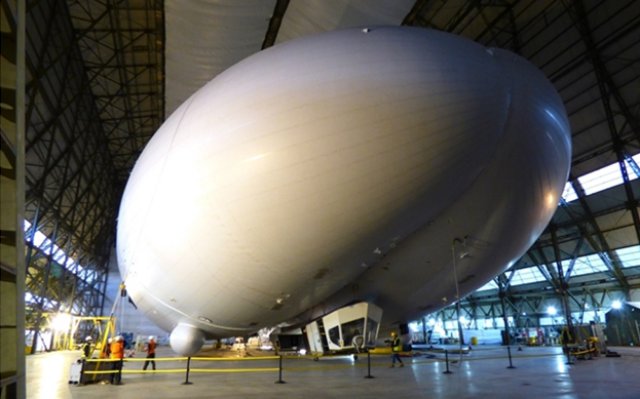2016 will be a momentous year for the future of aviation with the innovative Airlander 10 taking to the British skies for the first time – the construction team continues to make ground-breaking progress on a daily basis – most recently attaching the Mission Module to the iconic hull.
- Mission Module (which includes the Cockpit and Payload bay) is the latest external structure to be attached to Airlander’s hull
- Readying for Airlander’s First Flight
- Airlander on time and on budget
Already this month there have been a number of major attachments under the hull in preparation for the forthcoming First Flight of Airlander in spring, beginning with the fuel module at the rear of the aircraft, followed by the payload beam, (which will support bulky external cargo) and finally, the cockpit and payload bay (which we term the Mission Module) were attached this week.
“It’s very satisfying for the team and me to get another milestone under our belts. We’re hugely excited about the forthcoming Airlander First Flight this year.” – Mike Durham, Hybrid Air Vehicles’ Technical Director
How are these essential components attached to the hull? With pioneering British technology. The mass of the aircraft is supported from strengthened features built into the hull during manufacture. Multiple attachment points on each part of the structure allow the load to be distributed evenly.
Unlike traditional airships, the Airlander has no internal structure but it becomes rigid through being filled with helium, at just above atmospheric pressure. The super-strong hull material has been especially designed for us by Warwick Mills and assembled by ILC Dover, the company who make NASA spacesuits. Its innovative composition includes a woven fabric for strength on the inside, and a Tedlar layer for protection on the outside, sandwiching a mylar film to retain the helium.
The very latest materials, which are both strong and light, are used throughout the manufacture of our cutting-edge Airlander 10, ranging from the bespoke hull fabric to the mainly carbon composite Mission Module, Fuel Module, Ducts and engine support battens.
Hybrid Air Vehicles are the world leaders in hybrid aircraft, combining the best of aeroplanes and helicopters with lighter-than-air technology to bring brand new capabilities to aircraft. An Airlander produces 60% of its lift aerostatically (by being lighter-than-air) and 40% aerodynamically (by being wing-shaped) as well as having the ability to rotate its engines to provide an additional 25% of thrust up or down; this means the Airlander can hover as well as land on almost any surface, including ice, desert and even water! It produces less noise, less pollution, have a lower carbon footprint than conventional aircraft, and has longer endurance and better cargo-carrying capacity than any other flying vehicle.
Source: Press Release

